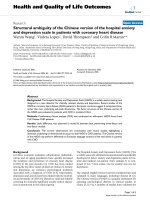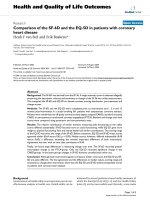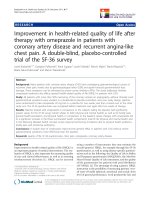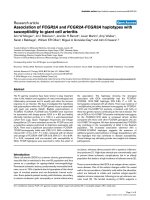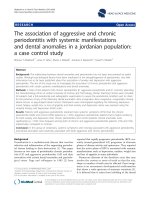ASSOCIATION OF CETP AND ADTRP GENES WITH CORONARY ARTERY DISEASE IN MULTI ETHNIC SINGAPOREAN POPULATION
Bạn đang xem bản rút gọn của tài liệu. Xem và tải ngay bản đầy đủ của tài liệu tại đây (1.13 MB, 108 trang )
ASSOCIATION OF CETP AND ADTRP WITH CORONARY ARTERY
DISEASE IN MULTI-ETHNIC SINGAPOREAN POPULATION
NAEIMEH TAYEBI
A THESIS SUBMITTED
FOR THE DEGREE OF MASTER OF SCIENCE
DEPARTMENT OF PEDIATRICS
NATIONAL UNIVERSITY OF SINGAPORE
2012
Declaration
I hereby declare that the thesis is my original work and it has been written by
me in its entirety.
I have duly acknowledged all the sources of information which have been used
in the thesis.
This thesis has also not been submitted for any degree in any university
previously.
Naeimeh Tayebi
December 2012
أ
Acknowledgements
I would like to thank:
A/Prof.Heng and A/Prof.Liu, who have been my great supervisor and cosupervisor respectively, their love of learning and insistence on perfection has
been great sources of inspiration. I am thankful to them for lending their trust,
attention, patience and support during this research and preparation of this
thesis; this would not have been possible without their help.
I wish to thank from Lye Hui Jen, Huang Ning and June-Mui Goh for teaching
the techniques in molecular biology to me, and Ke Tingjing, for helping me
with the experiments.
I wish to thank from my GIS friends: Foo Jia Nee, Low Hui Qi, Astrid
Irwanto, Herty Liany, Zhao Wanting, Rajkumar Dorajoo, and Li Jingmei, who
taught me statistical analysis.
I wish to thank from National University of Singapore for scholarship and all
of my good friends in Singapore, for their support and encouragement.
Naeimeh Tayebi
December 2012
ب
Table of Contents
Title page
Declaration page
I
Acknowledgments
II
Summary
1
List of Tables
4
List of Figures
5
List of Abbreviations
6
Chapter 1: Introduction
7
1.1. Definition of Coronary Artery Disease (CAD)
8
1.2. Prevalence of CAD
8
1.3. Pathogenesis of CAD
10
1.4. Conventional risk factors of CAD
11
1.4.1. Hyperlipidemia
12
1.4.2. Age and hypertension
13
1.4.3. Cigarette smoking
13
1.4.4. Diabetes mellitus
14
1.4.5. Coagulation factors
14
1.5. Genetic factors
1.5.1. Various genetic epidemiological approaches
1.6. Background and aims of present study
14
15
19
ت
Chapter 2: Methods
22
2.1. Record of demographic information
23
2.2. Blood sampling
23
2.3. Measurement of blood lipids
24
2.4. Extraction of genomic DNA
25
2.5. Optimization
26
2.6. Sanger sequencing
27
2.7. Statistical analysis
28
Chapter 3: Cholesteryl Ester Transfer Protein (CETP)
rs708272 and rs1800775 polymorphisms
31
3.1. Introduction
32
3.2. Study subjects
35
3.3. Genotyping and Sequencing
36
3.4. Results
40
3.4.1. Demographics of the Singaporean subjects
40
3.4.2. Frequency distribution of rs708272 and rs1800775
promoter polymorphisms in the three ethnic groups of
Singapore
3.4.3. Linkage disequilibrium between rs708272 and rs1800775
sites in the three ethnic groups of Singapore
3.4.4. Impact of CETP polymorphisms on plasma lipid profile
41
3.4.5. Gene environmental interaction
44
42
42
3.5. Discussion
57
3.6. Conclusion
61
ث
Chapter 4: The androgen-dependent TFPI regulating protein
(ADTRP) polymorphisms
62
4.1. Introduction
63
4.2. Study subjects
64
4.3. Genotyping
65
4.4. Results
68
4.4.1. Demographics of the Singaporean subjects
68
4.4.2. Association of rs6903956 with CAD in the three ethnic
groups of Singapore
4.4.3. Association between genotypic of rs6903956 and plasma
lipid profile
69
70
4.5. Discussion
76
4.6. Limitation and future direction
79
4.7. Conclusion
80
Chapter 5: Concluding remarks
81
Bibliography
85
Appendices
99
ج
Summary
Singapore’s multi-ethnic population structure and different prevalence and
mortality due to CAD in the ethnic groups provide an excellent opportunity to
discover further ethological factors CAD. In the study leading to this thesis,
two polymorphisms in the Cholesteryl Ester Transfer Protein (CETP), which
were results of a candidate gene approach and the polymorphism of androgendependent tissue factor pathway inhibitor (TFPI) regulating protein (ADTRP),
that was a result of validation of GWAS, were investigated in relation to CAD
and plasma lipid levels among the Chinese, Malay and Indian ethnic groups in
Singapore. The genotypic distribution of all the three polymorphisms was in
line with a population at Hardy Weinberg equilibrium (HWE).
The study of two polymorphisms (rs708272 and rs1800775) within the CETP
genes included 662 CAD cases with angiographically confirmed CAD
(CAD+) and 927 consecutive individuals from the general population. This
group is labeled as CAD- since those with a history of heart disorders or with
ECG abnormalities were excluded. For evaluation of allelic and genotypic
association of rs708272 and rs1800775 with CAD, subjects with dyslipidemia,
hypertension and diabetes were excluded and this subset of CAD- group was
labeled as healthy control group. For ADTRP gene (rs6903956), 645 CAD+
and 755 CAD- have been selected. We then tested the association of these
Single Nucleotide Polymorphisms (SNPs) with CAD and lipid profiles. The
B2 frequency of rs708272 was significantly lower in the Malays than the
1
Indians and Chinese in the healthy control. A similar significant trend was
observed for the A allele of rs1800775 polymorphism of CETP. Significantly
lower B2 and A allele frequencies were observed in the Chinese cases
compared to healthy controls. The absence of the B2 allele was associated
with CAD with an odds ratio (OR) of 2.0 (95% CI 1.2 to 3.4) after adjustment
for the confounding effects of age, cigarette smoking, BMI and gender. The
B2 allele of rs708272 and A allele of rs1800775 were significantly associated
with higher plasma HDL-C levels in the male Chinese CAD- after adjusting
for the significant confounding effects of age, BMI and smoking. The B2
allele had similar HDL-C elevating effects in the Indian women. However, in
the combined population, rs708272 showed only highly significant association
with plasma HDL-C.
The association of rs6903956 within ADTRP gene was also investigated with
CAD in the multi-ethnic Singaporean population. The risk allele A of
rs6903956 was associated significantly only in the Chinese cases with an OR
of 2.03 (95% CI 1.04-3.96, p-value = 0.037) when analyzed by each ethnic
group separately. In a meta-analysis, rs6903956 showed highly significant
association with CAD both before (observed p =1.39×10-4; OR= 1.66; 95% CI
1.28-2.15) and after adjustment (p-value = 4.63×10-3; OR =1.86; 95% CI 1.212.87) for conventional risk factors of age, gender, BMI, smoking status and
ethnicity. No significant association was observed between rs6903956
genotypes and lipid profiles in the Chinese, Malays and Indians, suggesting
2
that the association of this SNP with CAD is not mediated through plasma
lipids. The limitations of two studies are small sample groups especially for
the Malay and Indian populations. Therefore, further analysis in larger
numbers of cases and controls will help to confirm these results.
3
List of Tables
1.5.1.
The 36 loci associated with CAD/MI at Genome-Wide Levels
of statistical significance
18
2.6.
Components of cycle sequencing reaction
27
3.1.
Previous studies of polymorphisms in CETP gene
34
3.4.1.
Demographics of the Singaporean subjects
46
3.4.2.
Genotype and allele frequencies of the rs708272 and rs1800775
promoter polymorphisms in the three ethnic groups of Singapore
48
3.4.2a. The P-values between different Genotypes of the rs708272 and
rs1800775 promoter polymorphisms in the three ethnic groups of
Singapore before and after adjustment for age
49
Linkage disequilibrium coefficients between the rs708272 and
rs1800775 sites in the three ethnic groups of Singapore for CAD
cases and CAD-
50
3.4.3.
3.4.4a. Genotypic lipid levels (Mean SD) of the rs708272
polymorphism in the Chinese, Malays and Indian CAD- men
51
3.4.4b. Genotypic lipid levels (Mean SD) of the rs708272
polymorphism in the Chinese, Malays and Indian CAD- women
52
3.4.4c. Genotypic lipid levels (Mean SD) of the rs1800775 promoter
polymorphism in the Chinese, Malays and Indian CAD- men
3.4.4d. Genotypic lipid levels (Mean SD) of the rs1800775 promoter
polymorphism in the Chinese, Malays and Indian CAD- women
53
Clinical and biochemical characteristics of the Singaporean study
population
72
4.4.1.
54
4.4.2a. Association of rs6903956 genotypes with CAD
73
4.4.2b. Allelic association of rs6903956 with CAD
74
4.4.3.
75
Genotypic lipid levels (mean ± SD) of rs6903956 in the Chinese,
Malays and Indians CAD- controls
4
List of Figures
3.3a.
rs708272 genotypes
36
3.3b.
rs1800775 genotypes
38
3.3c.
rs1800775 sequencing
39
3.3d.
rs708272 sequencing
39
3.4.4.
Mean plasma HDL-C levels of the rs708272 and rs1800775
composite genotypes in male Chinese subjects
55
3.4.5.
Mean genotypic plasma HDL-C levels in male Chinese
according to A) BMI quartiles and rs708272 genotypes; B) BMI
quartiles and rs1800775 genotypes; C) Cigarette smoking and
rs708272 genotypes; D) Cigarette smoking and rs1800775
genotypes
56
4.3.
Rs6903956 genotypes
67
5
List of Abbreviations
CAD: coronary artery disease
SNP: Single Nucleotide polymorphism
MI: myocardial infarction
SMC: smooth muscle cell
ApoA: apolipoprotein A
ApoB: apolipoprotein B
CETP: Cholesteryl Ester Transfer Protein
ADTRP: Androgen-Dependent TFPI regulating protein
HDL-C: high density lipoprotein cholesterol
LPL: lipoprotein lipase
TC: total cholesterol
TG: triglyceride
BMI: body mass index
HTN: hypertension
BP: blood pressure
DBP: diastolic blood pressure
SBP: systolic blood pressure
CI: 95% confidence interval
OR: odds ratio
C: degrees in centigrade
min: minute
ml: milliliter
DNA: deoxyribonucleic acid
dNTP: deoxy nucleotide triphosphate
EDTA: ethylene diamine tetra-acetic acid
LDL-C: low density lipoprotein cholesterol
Log: logarithm
Lp(a): lipoprotein(a)
mg/dl: milligram per deciliter
PCR: polymerase chain reaction
RFLP: restriction fragment length polymorphism
n: number
rpm: revolutions per minute
SD: standard deviation
sec: second
SM: smoking
µl: microlitre
UV: ultraviolet
Vs.: versus
6
Chapter1: Introduction to Coronary Artery Disease
Chapter 1
Introduction to Coronary Artery Disease
7
Chapter1: Introduction to Coronary Artery Disease
1.1 Definition of coronary artery disease(CAD)
Coronary artery disease (CAD) is one of the most common diseases related to
the vasculature. CAD is the predominant cause of disability and death in all
industrialized nations (1). It is the narrowing or blockage of the coronary
arteries, usually caused by atherosclerosis. In more than 90% of cases, the
cause for myocardial ischemia is reduction in coronary blood flow because of
atherosclerotic coronary lesions. Atheromatous plaque consists of cholesterol
and fatty deposits on the inner walls of the arteries. These plaques can
diminish blood flow to the heart muscle by physically clogging the artery or
by causing abnormal artery tone and function. Consequently, there is an
imbalance between oxygen demand and blood supply.
1.2 Prevalence of CAD
About 80% of cardiac mortality is due to CAD. Annually, about 5 million
individuals are diagnosed as having CAD, resulting in approximately 600,000
deaths every year (1). The frequency of CAD has progressively increased in
most industrialized nations to almost epidemic proportions. CAD has become
more and more prevalent and is one of the principal causes of death in Eastern
and developing countries.
According to the World Health Organization (WHO), 23.6 million deaths each
year will be recorded by 2030 due to CAD (2). In the United States, the total
number of individuals affected by CAD is 15.8 million and the annual
8
Chapter1: Introduction to Coronary Artery Disease
incidence of myocardial infarction (MI) is 565,000 new attacks and 300,000
recurrent attacks, with an annual mortality of 157,000 (3). In United Kingdom,
according to British Heart Foundation, 101,000 deaths each year is attributed
to MI and according to Ministry of Health, Labor and Welfare of Japan, the
total number of Japanese affect by CAD is 910,000 and nearly 50,000 people
die annually from MI. However, there are vast differences of CAD morbidity
and mortality in different age groups, genders and races. Men uniformly have
higher incidence than women during their life. The CAD mortality in men is
also higher (4). The incidence and mortality of CAD also increases with age.
The data from National Center for Health Statistics showed that the incidence
of CAD dramatically increases in men over 45 years and in women over 55
years. The proportion of CAD deaths increased from 12% in men aged 35-44
years to 27% in men aged 65-74 years and from almost 1% to 23% in women
between the corresponding age groups (5). Various races often demonstrate
varying degree of morbidity and mortality from CAD. In the United States, a
study revealed that male blacks had less hazard of CAD mortality than male
whites, whereas female blacks showed an equal or higher rate than that of their
female whites’ counterparts (6, 7). In Trinidad (West Indies), a survey showed
that the incidence of the first CAD was 16.4 per 1000 person-years in men of
Indian origin, 6.8 per 1000 in men of African origin, 6-5 per 1000 in those
with European origin and 2.4 per 1000 in men with mixed origin (8). In Asia,
Japanese have been found to have low incidence and mortality for CAD (9).
9
Chapter1: Introduction to Coronary Artery Disease
Moreover, the incidence of CAD in Korea was as low as 8.5 per 100,000 in
1989 (10).
The 1998 National Health Survey showed the level of knowledge among
Singaporeans has increased on the benefits of leading a healthy lifestyle
including more exercise and less smoking. Nonetheless, the levels of high
blood cholesterol and hypertension (HTN) among them continue to increase.
In addition, the prevalence of obesity and diabetes remained unchanged (11).
The proportion of death due to CAD was 31.9%, 22.4% and 17.2% for the
Indians, Malays and Chinese respectively (12). Some cross-sectional studies
had indicated that some of the established risk factors for CAD, such as total
cholesterol (TC), low density lipoprotein cholesterol (LDL-C), HTN and
smoking, failed to explain the high excess of CAD in Singaporean Indians
(13). However, Indians in Singapore were found to have lower high density
lipoprotein cholesterol (HDL-C), Apo protein A1 (apoA1) and raised
lipoprotein (Lp (a)) levels compared to the ethnic Chinese (14).
1.3 Pathogenesis of CAD
The most important cause of CAD is diminished coronary perfusion relative to
myocardial demand. There is presumed to be a complex dynamic interaction
among fixed atherosclerotic narrowing of the epicardial coronary arteries,
intraluminal thrombosis overlying a disrupted atherosclerotic plaque, platelet
aggregation and vasospasm. Over 90% of the patients with one of the ischemic
10
Chapter1: Introduction to Coronary Artery Disease
heart diseases have the advanced coronary atherosclerosis with one or more
stenotic lesions causing at least 75% reduction of the cross sectional area of at
least one of the major sub pericardial arteries. The reduction will block the
augmented coronary flow needed to meet even the moderate increases in
myocardial demand. About one third of the patients have single-vessel,
another third have two-vessel, and slightly more than a third have three-majorvessel disease (15). The atheromatous plaque includes a focal plaque within
the intima of the vessel, having a core of lipid and a covering fibrous cap. The
lipid-core includes numerous lipid-loaded foam cells originating from
macrophages and smooth muscle cells (SMC), and an extracellular lipid-pool
which contains cholesterol, cholesterol ester, Lp(a) (16) and oxidized LDL
(17). Other components found inside the plaque include collagen,
proteoglycan (18), fibrin (19), T-lymphocytes (20) and complement
components (21). Focal rupture or gross ulceration or both of the luminal
surfaces of atheromatous plaques may result in exposure of highly
thrombogenic substances that induce thrombus formation. Hemorrhage into a
plaque may also occur from rupture of either the overlying fibrous cap or the
thin-walled capillaries that vascularize the plaque (22-24).
1.4 Conventional risk factors of CAD
The risk factors that predispose to the atherosclerosis and resultant CAD have
been identified in several prospective studies in well-defined population
groups (25). The method of establishing risk factors is one way to explore the
11
Chapter1: Introduction to Coronary Artery Disease
etiology of multifactorial diseases such as CAD. Over past several decades,
epidemiological studies have provided numerous evidences to establish the
following risk factors of CAD.
1.4.1 Hyperlipidemia
Hyperlipidemia is acknowledged to be a major risk factor for atherosclerosis.
Chronic hyperlipidemia may itself impair endothelial function. With chronic
hyperlipidemia, lipoproteins accumulate within the intima at sites of increased
endothelial permeability. The oxidative modification of lipid by free radicals
generated in the macrophages or endothelial cells in the arterial wall yields
oxidized LDL (26). Oxidized LDL is cytotoxic to endothelial cells and SMCs
and is also immunogenic, including the production of antibodies to oxidized
lipoproteins (27).
The major evidence implicating hypercholesterolemia in the genesis of
atherosclerosis includes the following:
- Genetic polymorphism defects in abundant genes involved in cholesterol
metabolism
contribute
to
atherosclerosis
susceptibility
such
as
Cholesterylester transfer protein (CETP) gene variations.
- There is a major decline in the rate of progression of the disease when the
levels of serum cholesterol are lowered by diet or drugs, resulting in the
lowering of the risk for CAD (28).Cholesterol lowering increases overall
12
Chapter1: Introduction to Coronary Artery Disease
survival risk and reduces risk of atherosclerosis related events in patients with
established CAD with elevated (29) or average (30) cholesterol levels as well
as in patients with hypercholesterolemia but without overt atherosclerosisrelated disease (31).
1.4.2 Age and HTN
Death rates from CAD rise with each decade even into advanced age. From
age 40 to 60 years, there is a greater than five-fold increase in the incidence of
MI. Atherosclerosis is a slowly progressive disease that begins in childhood
and develops slowly over decades (32). HTN is another major risk factor that
is stronger than hypercholesterolemia. Studies have shown that increased
death rates are associated with systolic blood pressure (SBP) greater than
140mm Hg and diastolic blood pressure (DBP) greater than 90 mmHg (25).
1.4.3 Cigarette smoking
Cigarette smoking is a well-established risk factor in the development of
CAD. A number of epidemiological studies have identified smoking as a
major risk factor for CAD (33). Animal and in vitro experiments showed that
the endothelium was injured due to smoking (34). Furthermore, cessation of
smoking was found to be correlated with decreased CAD risk (35).
13
Chapter1: Introduction to Coronary Artery Disease
1.4.4 Diabetes Mellitus
It has long been noticed that diabetic patients have much higher risk for CAD.
Some studies showed that the CAD mortality accounted for more than one
third of total deaths in diabetic patients (36). Although diabetic patients often
have other CAD risk factors such as obesity, HTN, hyperlipidemia and
elevated fibrinogen, diabetes mellitus still remained an independent risk factor
for CAD after these risk factors were taken into account (37).
1.4.5 Coagulation factors
The markers for thrombotic function include fibrinolysis and inflammation
such as elevated levels of plasminogen activator inhibitor-1, plasma fibrinogen
and C reactive protein (CRP). Studies have shown that CRP levels predict the
risk of MI (38). Other factors associated with CAD risk include lack of
exercise, lifestyle, weight gain etc. Epidemiologic studies also indicate a
protective role for moderate intake of alcohol.
1.5 Genetic factors
It is well known that genetic factors play an important role in the etiology of
CAD and contribute to the individual's susceptibility or resistances to the
disease.
The
biological
complexity of
atherosclerosis
implies
that
approximately 40% - 60% of unexplained variation in cardiovascular disease
risk can be attributed to genetic factors; hence it is necessary to identify these
specific molecular and genetic determinants (39-43).
14
Chapter1: Introduction to Coronary Artery Disease
1.5.1 Various genetic epidemiological approaches
One of the genetic epidemiological approaches to determine genetic variants is
based on candidate genes studies. This technique has reported multiple
positive findings for cardiovascular phenotypes. With this technique, we can
find association, provided information about the functionality in the pathway
of genes, which have been tested and are believed to have a role in the
biological pathway of the trait. Furthermore, this method takes advantage of
the increased statistical efficiency of association analysis compared to a
genome wide association study. However, candidate gene studies only tested
one to a few variants for association with CAD and these approaches cannot
discover unknown novel variants and also cannot evaluate how strong each
variant contribute to the susceptibility to CAD (44).
In parallel with candidate gene studies, other strategies such as genome wide
linkage analysis were carried out to interrogate the entire human genome and
it is based on the Mendelian cosegregation of a genetic marker within a
family. However, great efforts had to be made in order to collect sufficient
numbers of affected sibling pairs. The application of this strategy to
multifactorial disease is relatively limited (44).
Another approach is linkage disequilibrium mapping, which has proved a
valuable tool for locating disease genes. Although all existing linkage
disequilibrium
mapping methods
implicitly presume
that
individual
haplotypes can be inferred, only genotypes are directly observable in practice
15
Chapter1: Introduction to Coronary Artery Disease
and haplotypes cannot always be uniquely resolved based on genotype data. In
fact, this method relies on the availability of a set of individual high-risk
chromosomes and a set of individual normal chromosomes. The genetic
compositions of high-risk chromosomes such as haplotypes across a set of
genetic markers are inferred using the genotypes of the affected individuals
and the genotypes of their relatives. The haplotypes on the normal
chromosomes can be constructed either using chromosomes that are not
associated with the disease in the same set of pedigrees or unrelated normal
chromosomes in the same population (45).
With improved genotyping technologies and the completion of the human
HapMap project, genome wide association studies (GWASs) have gained wide
acceptance due to its comprehensive coverage of much of the human genome
(46). Over the last 6 years, GWAS has proved to be one of the most successful
approaches to study coronary atherosclerosis disease and have led to discovery
of some novel cellular genetic loci. Since the identification of the 9p21.3 locus
in 2007, which is so far the most robustly replicated genetic signal for CAD
around the world, several other loci have been identified by the Welcome
Trust Case Control Consortium (WTCCC) and the MI Genetics Consortium.
Recently, using GWAS, 36 loci (1p13, 1q41, 2q36, 3q22, 6p24, 6q25, 9p21,
10q11, 12q24, 15q22 and so on) of novel single nucleotide polymorphisms
(SNPs) associated with CAD and MI have been identified ( Table 1.5.1) and
many of them have been validated in other large Caucasian replication studies.
16
Chapter1: Introduction to Coronary Artery Disease
(47) In fact, one major limitation of GWAS is a high rate of false positives;
(48) thus, it is essential that rigorous replication studies in many independent
populations from different research groups replicate the findings and conform
to certain standards to ensure proper validation of identified loci (49). Studies
show that almost all the currently known CAD and MI loci were discovered in
the European populations. Although the 9p21.3 locus has been replicated in
the Asian populations (47), it is important to validate other identified novel
loci of European GWAS in the Asian cohort as well. Variants identified by
GWAS may not be causal but in strong linkage disequilibrium with the causal
ones that are located in genes or functional regions nearby. Fine mapping will
be needed for identifying causal variants and to derive more detailed
information about the region identified by GWAS analysis. In order to achieve
fine mapping, deep sequencing of the surrounding region is often done. In
addition, in vitro and in vivo studies using transgenic animal models have
identified or confirmed functional genes, creating potential new therapeutic
targets for decreasing the prevalence of heart disease (50, 51).
17
Chapter1: Introduction to Coronary Artery Disease
Table 1.5.1. The 36 loci associated with CAD/MI at Genome-Wide Levels of
Statistical Significance
Locus
SNP ID
Genes in Region
Risk
OR(95% CI)
Biological Mechanism
Allele
1p13.3
rs599839
CELSR2/PSRC1/SORT1
0.78(A)
1.11(1.08-1.15)
Lipoprotein and cholesterol metabolisms
1p32.3
rs17114036
PPAP2B
0.91(A)
1.17(1.13-1.22)
Unknown
1p32.3
rs11206510
PCSK9
0.82(T)
1.08(1.05-1.11)
LDL metabolism
1q41
rs17465637
MIA3
0.74(C)
1.14(1.09-1.20)
Unknown
2q33.1
rs6725887
WDR12
0.15(C)
1.14(1.09-1.19)
Unknown
2p24.1
rs2123536
TTC32-WDR35
0.39(T)
1.25(1.12-1.39)
Unknown
3q22.3
rs2306374
MRAS
0.18(C)
1.12(1.07-1.16)
Unknown
4q32.1
rs1842896
GUCY1A3
0.76(T)
1.23(1.11-1.37)
Unknown
6p21.31
rs17609940
ANKS1A
0.75(G)
1.07(1.05-1.10)
Unknown
6p21.32
rs9268402
C6orf10-BTNL2
0.59(G)
1.17(1.07-1.27)
Unknown
6p24.1
rs12526453
PHACTR1
0.67(C)
1.10(1.06-1.13)
Unknown
6p24.1
rs6903956
C6orf105
0.10(A)
1.51(1.34-1.70)
Unknown
6q23.2
rs12190287
TCF21
0.62(C)
1.08(1.06-1.10)
Unknown
6q25.3
rs3798220
LPA
0.02(C)
1.51(1.33-1.70)
Lipoprotein metabolism
7q22.3
rs10953541
BCAP29
0.75(C)
1.10(1.05-1.15)
Unknown
7q32.2
rs11556924
ZC3HC1
0.62(C)
1.09(1.07-1.12)
Unknown
9p21.3
rs4977574
CDNK2A/B/CDK2B-AS1
0.46(G)
1.29(1.23-1.36)
Increased proliferation of smooth muscle cells
9q33
rs7025486
DAB2IP
0.14(A)
1.09(1.04-1.15)
Unknown
9q34.2
rs579459
ABO
0.21(C)
1.10(1.07-1.13)
Unknown
10p11.23
rs3739998
KIAA1462
0.43(G)
1.10(1.06-1.13)
Unknown
10q11.21
rs1746048
CXCL12/HNRNPA3P1
0.87(C)
1.09(1.07-1.13)
Neointima formation after arterial injury, platelet activation
10q23.31
rs1412444
LIPA
0.34(T)
1.08(1.05-1.12)
Lipoprotein metabolism
10q24.32
rs12413409
CYP17A1/CNNM2/NT5C2
0.89(G)
1.12(1.08-1.16)
Unknown
11q22.3
rs974819
PDGFD/DYNC2H1
0.29(T)
1.09(1.05-1.13)
Unknown
11q23.3
rs964184
ZNF259/APOA5/4/1/APOC3
0.13(G)
1.13(1.10-1.16)
Unknown
12q21.33
rs7136259
ATP2B1
0.39(T)
1.21(1.11-1.33)
Unknown
12q24.12
rs3184504
SH2B3
0.44(T)
1.07(1.04-1.10)
Unknown
13q34
rs4773144
COL4A1/COL4A2
0.44(G)
1.07(1.05-1.09)
Unknown
14q32.2
rs2895811
HHIPL1
0.43(C)
1.07(1.05-1.10)
Unknown
15q25
rs4380028
MORF4L1/ADAMTS7/RPL21P116
0.60(C)
1.07(1.03-1.11)
Neointima formation, vascular remodeling
15q25.1
rs3825807
ADAMTS7
0.57(A)
1.08(1.06-1.10)
Unknown
17p11.2
rs12936587
RASD1/SMCR3/PEMT/RAL1
0.56(G)
1.07(1.05-1.09)
Unknown
17p13.3
rs216172
SMG6/SRR
0.37(C)
1.07(1.05-1.09)
Unknown
17q21.32
rs46522
UBE27/GIP/ATP5G1/SNF8
0.53(T)
1.06(1.04-1.08)
Lipoprotein metabolism
19p13.2
rs1122608
LDLR/SMARCA4
0.77(G)
1.14(1.09-1.18)
Unknown
21q22.11
rs9982601
SLC5A3/MRPS6/KCNE2/C21orf82
0.15(T)
1.18(1.12-1.24)
Unknown
in atherosclerotic lesions
18
Chapter1: Introduction to Coronary Artery Disease
1.6 Background of present study
Singapore is a relatively young country with the Chinese, Malay and India
immigrants (12). The Chinese community consists mainly of descendants of
Han Chinese settlers from the southern provinces of China, such as Fujian and
Guangdong, and currently represents the dominant racial population in
Singapore, accounting for 76.7% of the resident Singaporean population. The
Malay population account for 13.9% of the Singapore population (52).
Moreover, the Indian migrants in Singapore were from the Indian
subcontinent, with the majority consisting of Telugas and Tamils from
southeastern India and a minority of Sikhs and Pathans from north India and
accounts for 7.9% of the Singapore population.
The immigrant Chinese and Indians have lived together with native Malays for
the past two to three generations, with shared socio-economic environment
and to some extent integrated dietary habits. However, their incidence and
mortality of CAD, as mentioned above, are markedly different. The
Singaporean Indians has the highest mortality from CAD in both men and
women (49). As mentioned earlier, overseas Indians around the world have
been widely reported to have higher CAD death rate compared to their
compatriots (53). It has been observed that Indians have low levels of HDL-C
(54). The high prevalence of diabetes mellitus among Indians is well known
(55). These two points seem to be consistent with the high incidence and
mortality of CAD in the Indians. However, smoking is not always more
19
